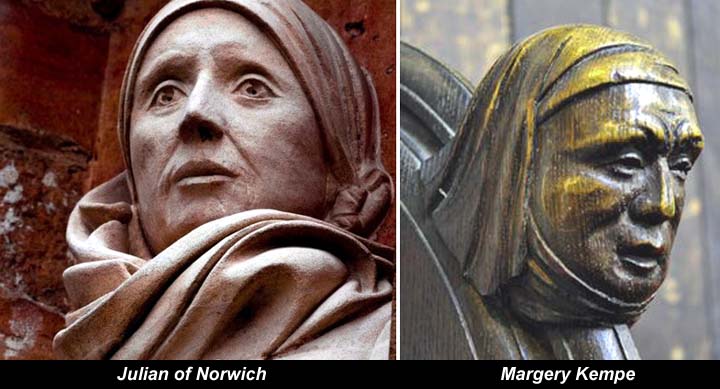|
The future is unwritten
Join Date: Oct 2002
Posts: 71,105
|
Jan 1st, 2016: Anchorite
Since it’s New Years and everyone is still partying, zombified, or sleeping it off, I slip this woman in here. Julian of Norwich wrote the first published book attributed to a woman in all of English literature. She was an Anchoress (female Anchorite) in 14th century England.
Wiki
Quote:
|
Anchorite or anchoret (female: anchoress; adj. anchoritic; from Ancient Greek: ἀναχωρητής, anachōrētḗs, "one who has retired from the world", from the verb ἀναχωρέω, anachōréō, signifying "to withdraw", "to retire") denotes someone who, for religious reasons, withdraws from secular society so as to be able to lead an intensely prayer-oriented, ascetic, and—circumstances permitting—Eucharist-focused life. Whilst anchorites are frequently considered to be a type of religious hermit, unlike hermits they were required to take a vow of stability of place, opting instead for permanent enclosure in cells often attached to churches. Also unlike hermits, anchorites were subject to a religious rite of consecration that closely resembled the funeral rite, following which—theoretically, at least—they would be considered dead to the world, a type of living saint. Anchorites had a certain autonomy, as they did not answer to any ecclesiastical authority other than the bishop.
|

Quote:
There were anchorites all over Europe, but the lifestyle particularly caught on in England, and, within the country, in Norwich more than anywhere else. These days, the 133,000-person city is one of the least religious in the U.K., but in the middle ages, while York had 10 recluses at the height of the trend and London had twelve, Norwich had 35. Back then, Norwich was one of the largest cities in England, second only to London, and it was distinguished by the number of unusually devout people living there.
Part of the reason the city had that reputation was Julian of Norwich, who lived in the 14th century in an anchorhold at St. Julian's Church. When she was 30 years old, in 1373, she experienced a series of visions that inspired her to leave behind her previous life and dedicate herself to contemplation. Her own name is not known, but she was a famous enough anchorite that there are many records of people bequeathing her money–a rarity.
|
Enter Tah Dah(French Horns) Margery Kempe, who wrote(dictated) what is commonly considered to be the first autobiography written in the English language.
Quote:
|
Her visions, devotion and writings made her well-known enough that Margery Kempe sought her out. Kempe was a sort of wild mystic who was dedicated to Christianity but performed her own spiritual vision very publicly. She wanted a sort of blessing from Julian of Norwich, and, according to her own account, she got what she wanted. Julian told her to obey the will of God, to follow what he had put in her soul, to ignore what the world might say, and to have patience. Kempe would need this advice, as following what God put into her soul drew criticism from men in places of power; she was sometimes described as a madwoman.
|
Link
Quote:
|
Part of Margery Kempe's significance lies in the autobiographical nature of her book; it is the best insight available of a female, middle class experience in the Middle Ages. Kempe is unusual when compared to contemporaneous holy women, such as Julian of Norwich, because she was a laywoman. Although Kempe has sometimes been depicted as an "oddity" or a "madwoman," recent scholarship on vernacular theologies and popular practices of piety suggest she was not as odd as she might appear. Her Book is revealed as a carefully constructed spiritual and social commentary. Some have suggested that her book is written as fiction and a form of artistry, implying that she intentionally "attempts to create a social reality and to examine that reality in relation to a single individual." By focusing on a single person's experience, Staley suggests, Margery is able to explore the aspects of the society in which she lived in a realistic way. The suggestion that Kempe wrote her book as a work of fiction is supported by the fact that she regards herself as "this creature" throughout the text, dissociating her from her work. Although this is considered by some to be the first autobiography in the English language, there is also evidence that Kempe may have written her book not entirely about herself or to precisely document her personal experiences, but as a work which explores the experience of one person and which sheds light on life in an English Christian society.
|
In 1539 Henry the VIII put a stop to Anchorites in England. Get thee to a scullery, bitch.
__________________
The descent of man ~ Nixon, Friedman, Reagan, Trump.
|